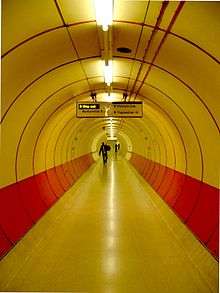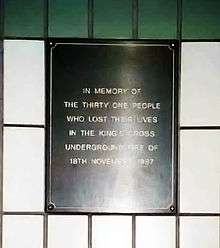King's Cross St. Pancras tube station
| King's Cross St. Pancras | |
|---|---|
|
Entrance on Euston Road outside King's Cross station concourse. | |
 King's Cross St. Pancras Location of King's Cross St. Pancras in Central London | |
| Location | King's Cross / St Pancras |
| Local authority | London Borough of Camden |
| Managed by | London Underground |
| Owner | London Underground |
| Number of platforms | 8 |
| Accessible | Yes |
| Fare zone | 1 |
| OSI |
London King's Cross London St Pancras Int'l |
| London Underground annual entry and exit | |
| 2013 |
|
| 2014 |
|
| 2015 |
|
| 2016 |
|
| Key dates | |
| 1863 | Opened (MR) |
| 1906 | Opened (GNP&BR) |
| 1907 | Opened (C&SLR) |
| 1968 | Opened (Victoria line) |
| 1987 | King's Cross fire |
| Other information | |
| Lists of stations | |
| External links | |
| WGS84 | 51°31′49″N 0°07′27″W / 51.5302°N 0.1241°WCoordinates: 51°31′49″N 0°07′27″W / 51.5302°N 0.1241°W |
|
| |
King's Cross St. Pancras is a London Underground station located within the London Borough of Camden. It serves King's Cross and St Pancras main line stations and falls within fare zone 1. Being an interchange station between six lines, (the Circle, Hammersmith & City, Metropolitan, Northern, Piccadilly and Victoria lines) it is the second busiest station on the network, second only to Waterloo.
Interchange
King's Cross St Pancras is the biggest interchange station on the London Underground, serving six lines on four pairs of tracks as well as two National Rail stations:
- On the Hammersmith & City / Circle / Metropolitan lines, between Euston Square (west) and Farringdon (east). The three lines share common tracks in this area.
- On the Northern line Bank branch, between Euston (south-west) and Angel (east).
- On the Piccadilly line, between Russell Square (south-west) and Caledonian Road (north-east).
- On the Victoria line, between Euston (south-west) and Highbury & Islington (north-east).
- King's Cross serves long distance inter city services on the East Coast Main Line and regional services mainly for commuters, the next station being Finsbury Park.
- St. Pancras station provides inter-city services on the Midland Main Line, international and high speed commuter services via High Speed 1 and commuter services via Thameslink, and international services operated by Eurostar
Ticket halls
The underground part of the station underwent extensive remodelling works to increase throughflow of passengers resulting from the opening of High Speed 1. The expanded station has four entrances, and was opened to the public in November 2009.
- The main ticket hall is in front of King's Cross station. It has been expanded and refurbished and is signposted as the 'Euston Road' way out from the tube lines.
- The Pentonville Road entrance was the former ticket hall for King's Cross Thameslink station and has underground passageway connections to the Piccadilly and Victoria lines. It was taken over by London Underground when the Thameslink platforms closed.
- The Western Ticket Hall is under the forecourt of St Pancras station, adjacent to Euston Road. It provides access to St Pancras Station via the St Pancras undercroft and opened on 28 May 2006.
- The Northern Ticket Hall is west of King's Cross station platform 8, underneath the main concourse. The London Underground ticket hall and associated connections to the tube lines were opened on 29 November 2009. It is signposted as the 'Regent's Canal' way out from the tube lines.
History

The first underground station at King's Cross opened as part of the original section of the Metropolitan Railway in 1863 and was rearranged in 1868 and 1926. New platforms for the sub-surface lines of the Underground were opened about 400 m (440 yd) to the west in 1941 to make interchanging between the sub-surface lines and the tube lines easier; the 1868 platforms later became the former King's Cross Thameslink station, which closed on 9 December 2007 when the Thameslink service moved to St Pancras International. One of the platforms may be seen from Underground trains between the present station and Farringdon.
The Great Northern, Piccadilly and Brompton Railway (GNP&BR, now part of the Piccadilly line) platforms opened with the rest of the line in December 1906, while the City & South London Railway (C&SLR, now part of the Northern line) arrived in May 1907. The Victoria line platforms came into use on 1 December 1968 with the opening of the second phase of the line. The Victoria line escalators cut through the location of the original Piccadilly line lifts.

On 18 November 1987 the station was the scene of a devastating fire that killed 31 people. The cause was attributed to a lit match falling into the space under the escalator, setting fire to the grease and rubbish present there, then to the wooden parts of the escalator. The then-unknown fire phenomenon of the trench effect made the fire develop upwards and finally caused it to explode into the station.[2] As a result, fire safety procedures on the Underground were tightened, staff training was improved and wooden steps on escalators were replaced with metal ones. The existing prohibition of smoking throughout the London Underground network was tightened. Due to the extensive damage caused by the fire, it took over a year to repair and reopen the station; the Northern line platforms and the escalators from the ticket hall to the Piccadilly line remained closed until 5 March 1989.
On 7 July 2005, as part of a co-ordinated bomb attack, an explosion in a Piccadilly line train travelling between King's Cross St Pancras and Russell Square resulted in the deaths of 26 people.
Platform level tiling
The stations along the central part of the Piccadilly line, as well as some sections of the Northern line, were financed by Charles Yerkes,[3] and are famous for the Leslie Green designed red station buildings and distinctive platform tiling. Each station had its own unique tile pattern and colours.
Future proposals
Crossrail 2
Since 1991, a route for a potential Crossrail 2 has been safeguarded, including a connection at King's Cross St Pancras and Euston, forming the station Euston King's Cross St Pancras.[4] The proposed scheme would offer a second rail link between King's Cross and Victoria in addition to the Victoria line. The locations for any new stations on the route will depend on the loading gauge of the final scheme. In the 2007 safeguarded route, the next stations would be Tottenham Court Road and Angel.
York Road
In 2005 a business case was prepared to re-open the disused York Road tube station on the Piccadilly line, to serve the Kings Cross Central development and help relieve congestion at King's Cross St Pancras.[5] York Road station closed in 1932 and was about 600 m (660 yd) north of King's Cross St Pancras.
Connections
London Buses routes 10, 17, 30, 45, 46, 59, 63, 73, 91, 205, 214, 259, 390 and 476 and night routes N63, N73, N91 and N205 serve the station.
See also
References
- 1 2 3 4 "Multi-year station entry-and-exit figures" (XLS). London Underground station passenger usage data. Transport for London. March 2017. Retrieved 28 May 2017.
- ↑ Paul Channon (12 April 1989). "King's Cross Fire (Fennell Report)". Parliamentary Debates (Hansard). House of Commons. col. 915–917.
- ↑ "The Man Who Painted London Red". londonreconnections.com. 1 January 2010.
- ↑ "Crossrail 2: Scheme description". London Borough Islington. Archived from the original on 2004-11-10.
- ↑ "York Road Station Re-opening - Business Case Analysis" (PDF). Halcrow Group Limited. 2005. p. 6. Archived from the original (PDF) on 2011-07-26.
The objective would be to ensure that public transport users travelling from the KCC development would benefit from travelling via York Road Station rather than using King’s Cross St Pancras Station. This in turn leads to the subobjective of providing congestion relief for King’s Cross St Pancras Station.
External links
| Wikimedia Commons has media related to King's Cross St. Pancras tube station. |
- "Photographic collection". London Transport Museum.
- "More photos of King's Cross St. Pancras". Tube Photos.
- "Schematic plan of station following completion of Northern Ticket Hall in November 2009". Parking in Stevenage Blog.
| Preceding station | Following station | |||
|---|---|---|---|---|
towards Hammersmith | Circle line | |||
| Hammersmith & City line | towards Barking |
|||
| Metropolitan line | towards Aldgate |
|||
| Northern line | ||||
| Piccadilly line | towards Cockfosters |
|||
towards Brixton | Victoria line | towards Walthamstow Central |
||
| Former services | ||||
towards Hammersmith | Metropolitan line Hammersmith branch (1864-1990) | towards Barking |
||
towards South Harrow | Piccadilly line (1906–32) | towards Finsbury Park |
||
